Scholars' insights on Shakespeare's Sisters: Voices of English and European Women Writers, 1500-1700
This article is related to the exhibition. For other uses, see Shakespeare's Sisters (disambiguation).
This article offers modern scholars' insights into the rich literary lives of the women featured in the Shakespeare's Sisters: Voices of English and European Women Writers, 1500-1700 exhibition.
Lady Anne Clifford, Diarist and Historian (case 1)
Georgianna Ziegler on Lady Anne Clifford
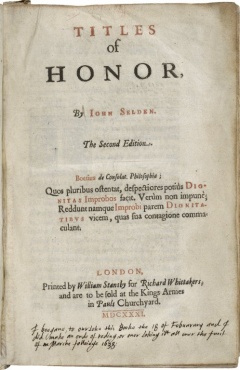
I was very excited a couple of years ago when a special copy of John Selden’s Titles of Honor came into the Folger collection. We already had two copies, but what made this one so special was the fact that it had been owned by Lady Anne Clifford, one of the greatest women of her age. There on the title page is her inscription saying that she read and “over looked” the book in the winter of 1638. What does she mean by “over looked”? Lady Anne was what we would call a multi-tasker – that is, she frequently had one of her secretaries read to her while she was doing something else. This book is full of underlinings and marginal marks, probably made by her secretaries, but obviously at her command. By “over looking” I think she meant that she went back over the book, perhaps as the chapters were read, and made sure the passages were marked that she wanted. There are even a number of original paper bookmarks stuck in.
Lady Anne had a major collection of books, but she was especially interested in this volume because Selden wrote about lineage and how different titles and property pass in families through the male or female heirs. When she was fifteen, Lady Anne’s father died, leaving his vast Yorkshire estates not to her – his heir – but to his brother. Lady Anne spent most of the rest of her life trying to get back these estates. The lawyer and antiquarian John Selden was a friend of hers, and it is possible that he was one of the experts whom she called upon over the years to help with the claims to her properties. Certainly, his Titles of Honor was a book that she consumed with much interest because it traced the history and customs of titles from ancient times and as they came to be used in England.
At first she was helped by her mother, but after Lady Margaret Clifford’s death, Anne had to go it alone. Though both of her husbands -- first Richard Sackville, 3rd earl of Dorset and then Philip Herbert, 4th earl of Pembroke -- were powerful men, neither helped her bring about the settlement. After their deaths, Anne continued to pursue her interests. She hired antiquarians to search old records and translate them from Latin or French, and then had them bound into three large volumes. She also wrote hundreds of pages of diaries which document her life while constantly relating it back to what had gone before, placing her in a historical continuum.
Finally, in 1643, the last of the Clifford male heirs died, leaving Anne the sole inheritor of the estates at the age of 53. She could now style herself Countess of Dorset, Pembroke, and Montgomery, “Barones Clifford Westmorland and Vescy; and High Shreives of that County and Lady of the Honor of Skipton in Craven.”† She had become the greatest female landowner in England.
† Quoted from one of her Great Books in Spence, p. 160.
Listen to Ziegler discuss diarist Lady Anne Clifford.
Georiganna Ziegler has written on Lady Anne Clifford, Esther Inglis, and Elizabeth I, including the exhibition catalog, Elizabeth I: Then and Now. She is Louis B. Thalheimer Head of Reference at the Folger Shakespeare Library, and is the curator of the exhibition Shakespeare's Sisters.
Elizabeth Cary, The Reply (case 2)
Heather Wolfe on Elizabeth Cary
The Reply of the Most Illustrious Cardinall of Perron to ….the most excellent King of Great Britaine is a polemical religious work written by the French Catholic Cardinal Jacques Davy du Perron, translated by Elizabeth Cary, viscountess Falkland, and printed in France in 1630.
Borrowed from the Beinecke Library at Yale, the copy on exhibit (not pictured) is one of at least six surviving copies that Elizabeth Cary apparently had prepared as presentation copies—including a manuscript sonnet dedication to Queen Henrietta Maria, as well as tipped-in engravings of Cardinal Perron, identical fine morocco bindings, and virtually identical corrections to the text.
According to her biography written by her daughters, most copies of The Reply were seized and burned by the archbishop of Canterbury when they arrived in England, but “some few copies came to her hands.” Copies were probably burned because the book spoke out against the king and the oath of allegiance.
Elizabeth Cary converted to Roman Catholicism in 1626, only four months after Charles I had married the French Catholic princess Henrietta Maria. She was religious, highly educated, and fluent in multiple languages, and after extensive reading and debate, decided that the Church of England’s claims to be a reformed version of the Catholic Church were false. Her translation was part of a much larger religious debate, conducted in multiple languages over many years.
Today Elizabeth Cary is chiefly remembered for being the first female playwright to have a play published in English, The Tragedy of Mariam, but in her own lifetime and in the years after her death, she was admired by Roman Catholics in England and abroad for this important translation.
Listen to Wolfe discuss Elizabeth Cary's The Reply.
Heather Wolfe is curator of manuscripts at the Folger Shakespeare Library. She edited The literary career and legacy of Elizabeth Cary, 1613-1680 (2007) and Elizabeth Cary, Lady Falkland: Life and Letters (2001) and has written widely on early modern manuscript culture.
Mary Sidney, Psalms (case 2)
Margaret Hannay on Mary Sidney
During her life, Mary Sidney was one of the most famous women in England, celebrated for her writing, particularly her translation of the biblical Psalms into English poems. Her brother, Sir Philip Sidney, had translated approximately one third of the Psalms, and she completed them after his death. The title on the Bodleian Library's Rawlinson manuscript (not pictured) calls them “more rare, and excellent, for the method and varietie then ever yet hath been done in English” because the Sidneys used so many different verse forms, including the sonnet. Mary Sidney was also a scholar who consulted virtually every Psalm version and commentary available to her in English, French, and Latin, and she may have even studied a little Hebrew, or at least talked with Hebrew scholars. In her Psalms versions, she adds wordplay and expands metaphors. Such expansions frequently reflect her own experience, like the bride in an arranged marriage, or a woman who has experienced childbirth. The delight she took in writing these poems is evident in her version of Psalm 75:
And I secure shall spend my happy times in my, though lowly, never-dying rhymes, singing with praise the God that Jacob loveth.
Here she combines humility (her own “lowly” rhymes) with confidence in the importance of these “never-dying rhymes” that praise God.
William Shakespeare performed for the Pembroke household, but he probably used the servants’ entrance. Actors did not have the status of Mary Sidney Herbert, countess of Pembroke, who was the daughter of Sir Henry Sidney, governor of Ireland and Wales; the sister of the famous author Sir Philip Sidney, celebrated as a Protestant martyr; and the wife of Henry Herbert, earl of Pembroke, one of the richest men in England. Her London house, Baynards Castle, once a royal palace, spread out over several city blocks in the most fashionable district along the Thames River. From there she travelled by boat to the court of Queen Elizabeth and later King James. At her country estate of Wilton House she encouraged poets and scholars, so that her home was known as a ‘little university’.
Listen to Hannay discuss Mary Sidney's translations of the Psalms.
Margaret Hannay, Professor of English at Siena College, is the author of Philip's Phoenix: Mary Sidney, Countess of Pembroke (Oxford UP, 1990), and of Mary Sidney, Lady Wroth (Ashgate, 2010). She is the editor of Mary Sidney, Countess of Pembroke. Ashgate Critical Essays on Women Writers in England, 1550-1700. Vol. 2 (2009), and of Silent but for the Word: Tudor Women as Patrons, Translators and Writers of Religious Works (Kent State UP, 1985). She has edited, with Noel J. Kinnamon and Michael G. Brennan, The Collected Works of Mary Sidney Herbert, Countess of Pembroke (Oxford UP, 1998); and, with the addition of Hannibal Hamlin, The Sidney Psalter: The Psalms of Philip and Mary Sidney for the Oxford World Classics series (2009).
Laura Battiferri, Psalms (case 3)
Victoria Kirkham on Laura Battiferri
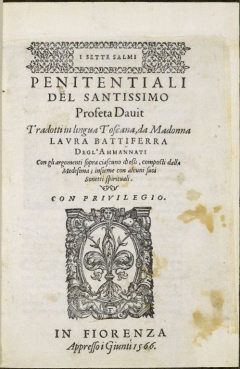
The title page of Laura Battiferri’s Seven Penitential Psalms emphasizes in the printer’s hierarchy of type fonts the word “penitential,” isolated on a single line and in larger letters than any other information to greet the reader. Tradition, which the translator follows, attributed these poetic prayers to King David, remorseful for his adultery with Bathsheba. As understood by the community of faithful, David’s voice becomes that of the Christian soul who cries out in sorrow over sin. The book itself is open to the central, fourth Penitential Psalm (Psalm 50), the great “Miserere”: “Have mercy on me, o Lord.”
Significantly, Battiferri first published her Salmi penitentiali in 1564, just a few months after the final session of the Council of Trent, which had been meeting intermittently for nearly twenty years to bring major reforms to the Church. Its decrees define the Catholic Reformation and inaugurate a new climate of religious austerity. Announced as a translation “into the Tuscan language," Battiferri's Psalms immediately place her in the family of the classic Tuscan writers--Dante, Boccaccio, and above all, Petrarch.
In her translation of the Psalms, Battiferri preserves the original Latin in the margins, and she uses a vocabulary that calls to mind Petrarch’s sonnets. Countless sixteenth-century imitators, including many women, adopted this mode of writing, called Petrarchismo. While the Council of Trent took a position against vernacular translations of the Bible, which flourished in Protestant circles, Battiferri could escape suspicion of heresy by choosing the widely accepted literary vechicle of Petrarchismo.
Finally, a sequence of “spiritual sonnets” rounds out Battiferri’s volume. These poems were circulating in manuscript by 1561, as we can deduce from a letter written that year by her husband, the sculptor and architect Bartolomeo Ammannati. First to receive them, tucked into the back of a copy of her Petrarchan lyric anthology, was Ammannati’s mentor and a family friend, Michelangelo
A native of Urbino, Laura Battiferri was born illegitimately to a pre-Reformation churchman and his concubine. Her wealthy father, a Vatican cleric, provided her with a humanist education. In correspondence with the most celebrated poets and artists of her day, she lived all her life in court circles. This realm of privilege, both intellectual and social, explains the high station of the nuns she choses as recipients of her Psalms.
Listen to Kirkham discuss Battiferi's translations of the Psalms.
Victoria Kirkham, Professor Emerita of Romance Languages at the University of Pennsylvania, studied at Wellesley College, the University of Illinois, and Johns Hopkins. Among her honors are fellowships from the Fulbright Program, the Harvard Center for Renaissance Studies in Florence, the National Endowment for the Humanities, and the Guggenheim Foundation. Her publications include books and articles on Dante, Petrarch, and Boccaccio, and Italian cinema, as well as the edition with commentary Laura Battiferra and Her Literary Circle: An Anthology (University of Chicago, 2006).
Esther Inglis, Psalms (case 3)
Georgianna Ziegler on Esther Inglis
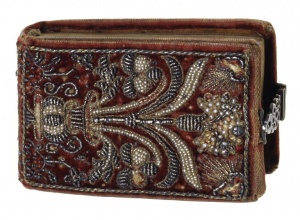
Some of my favorite things in the Folger collection are the little handmade books by Esther Inglis. Many of these she made by writing out biblical texts from the Psalms, Proverbs, or Ecclesiastes, using a different script on every page. Often she adorned the pages with colorful flowers or with black-and-white decoration which sometimes looks like stitching. It appears that she also made some of the bindings herself, such as the lovely one she made for Prince Henry, stitched with silver-gilt thread and seed pearls on red velvet. Inglis' other book of Psalms on display is bound in brown velvet with a silver-gilt embroidered frame on the front cover surrounding a coat-of-arms. She presented this volume to Prince Maurice of Nassau, head of the United Provinces of the Netherlands and a staunch Protestant.
Esther Inglis was born into a family of Huguenots who fled persecution in France around 1569 before settling in Edinburgh. Her father was master of the French School there, and her mother was a talented calligrapher. It was from her mother that Esther likely learned to write the varied and beautiful scripts that form the art of calligraphy.
Inglis saw herself as doing God’s work. She made many of these pocket-sized books for English and French courtiers of the time of James I who supported the Protestant cause, and she often refers to herself as God’s handmaid. In the self-portraits she includes in some of her books, she shows herself standing behind a table, pen in hand, with a book on which is written, "De l’Eternel le bien, de Moi le mal ou rien" —from Eternal God comes all good; from myself comes nothing of value— reiterating the Protestant notion that all good gifts come from God and that we are worthy only through God.
Close to sixty of Esther Inglis’s handmade books survive today. Most of them are in the National Library of Scotland, but the Folger Library is fortunate to own four of these miniature manuscripts.
Listen to Ziegler discuss Inglis' pocket-sized editions of the Psalms.
Mary McKinley on Marguerite de Navarre
Marguerite (1492–1549), queen of Navarre and sister of the king of France, Francis I (1494–1547) collected her poems in a small volume titled Marguerites de la marguerite des princesses (not pictured). The title is a play on the word marguerite in French; in English it becomes Pearls of the Pearl of Princesses. Better known today as the author of the Heptameron, Marguerite, an advocate for reform within the Catholic Church, had been writing deeply religious poetry at least since the 1520s. In 1531, her mystical poem Mirror of the Sinful Soul was printed in Alençon, to be re-printed in Paris in 1533. By then, Marguerite had aroused the anger of the conservative Parisian theologians, who attacked the Mirror before royal pressure intervened and made them retreat. The young Elizabeth Tudor, future Queen Elizabeth I of England, later translated the Mirror into English, working from a copy brought from France by her mother, Anne Boleyn.
Efforts to reform the French Church became increasingly perilous after 1534, when a group of radical reformers from Switzerland posted in Paris and widely throughout France broadsheets attacking the Catholic Mass. Shaken by threats to the order of his kingdom, Francis ordered harsh persecution of those perceived to be heretics. Court poet Clement Marot and young John Calvin were forced to flee and sought refuge at Marguerite’s court in Nérac before escaping to Italy. During those trying times, Marguerite wrote prolifically, but it was not until 1547, the year of her brother’s death, that she collected many of her works in the first edition of the Marguerites, published by Jean de Tournes in Lyon, France. The book on exhibit appeared two years later, also in Lyon. It carries the name of Pierre de Tours and contains essentially the same poems as the first edition. Its appearance suggests that there was high demand for Marguerite’s collected works, and its smaller format would have made it more affordable.
The Marguerites has an intricate frame around the title. Its leafy garlands, masks, and playful winged putti are typical of frames produced by artists in the School of Fontainebleau who flourished under the patronage of King Francis I.
Listen to McKinley discuss Marguerites de la marguerite des princesses.
Mary McKinley is editor and translator of Marie Dentière's Epistle to Marguerite de Navarre. She focuses on early modern French literature, especially Montaigne, Marguerite de Navarre, and Marie Dentière. She is Douglas Huntly Gordon Professor of French at the University of Virginia.
Louise Labé, Oeuvres (case 5)
Deborah Lesko Baker on Louise Labé
Louise Labé was a provocative early modern French woman writer, born around 1520 into a bourgeois family in Lyon, France’s cultural capital in the mid-sixteenth century. Her father was a ropemaker, who, although illiterate himself, saw to it that his daughter’s upbringing went beyond home and hearth, and had her educated in Classical and modern languages. Thanks to the active civic role of its bourgeois merchants, Lyon took a flexible stance toward certain class and gender conventions – namely that women had to be confined to the domestic sphere.
However, paternally arranged marriages remained the norm, and her father’s progressive educational ideas didn’t stop him from giving Louise’s hand in marriage around 1542 to an older Lyonnais ropemaker. Still, Lyon’s progressive social strand allowed Labé to write and publish in its urban literary circles. Her pride in her Lyonnais heritage is clear on the title page, where she is identified as Louise Labé Lyonnaise. Her volume includes a now famous letter advocating women’s education and writing, together with a prose debate on the problems of male-female relations, three Latin-inspired love elegies, and twenty-four love sonnets inspired by Petrarch’s Italian lyric tradition.
Perhaps nowhere is Labé’s original voice more striking than in her love sonnets. Her female speaker is no longer the inaccessible object of Petrarchan male desire, but a self-declared subject of desire who extols a vision of mutual physical and spiritual love between a man and a woman in the here and now. For a woman writing in the sixteenth century this is a revolutionary stance indeed.
Hear Baker discuss Louise Labé's works.
Deborah Lesko Baker is Professor of French at Georgetown University. She is the author of The Subject of Desire: Petrarchan Poetics & the Female Voice in Louise Labé and Narcissus & the Lover: Recovery & Reinvention in Maurice Scève’s ‘Délie’, as well as articles on Renaissance poetry and mythic structures in literary texts. She is the editor and co-translator of the first bilingual critical edition of Louise Labé’s 1555 Complete Works, published by the University of Chicago Press in 2006.
Gaspara Stampa, Rime (case 5)
Jane Tylus on Gaspara Stampa
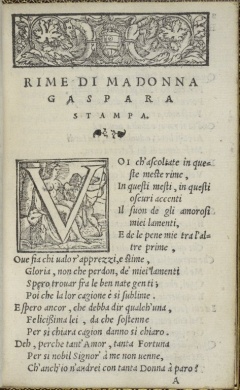
In Venice, gateway to the East, city of gondolas, canals, and lively gatherings, sophisticated men and women were entertained by talented young singers such as Gaspara Stampa. Brought by her widowed mother to Venice as a young girl, Stampa was well-read in the classics of Italian literature as well as Latin and possibly Greek. Her ambitions to be more than just a "virtuosa" – a musician – are clear from the collection of 310 poems left unpublished at Gaspara’s sudden death in 1554 when she was only thrity years old. Her sister Cassandra writes that "certain learned gentlemen" implored her to publish Gaspara’s poems rather than hiding them under a bushel – and we are glad that she did.
Gaspara wrote many of her poems about the aristocrat Collaltino di Collalto, whom she may have met at one of the gatherings where she sang. We do know that it was "around Christmas" when, she claims, her lord "made himself a nest and refuge in my heart." This unabashed reference to herself as a pregnant Mary and Collaltino as Christ is characteristic of Gaspara’s daring verse, in which she counts herself among the greatest lovers of all time. "Alas that I alone defeat the infinite!" she cries in sonnet 90, and in her first poem she imagines the envy her poems will inspire in future women readers. Yet when Collaltino predictably left her, Gaspara fell in love with another aristocrat, one Bartolomeo Zen, whose name is spelled out in the first letters of each line of sonnet 216. We thus have a rare instance of poems directed to more than one male beloved, as Stampa refers to herself as a salamander who lives in flame, a phoenix born from her own ashes.
A performer to the end, Gaspara surprises, even shocks with her emotional and lyrical range. It may be that their scandalous sentiments led to the poems' neglect for almost two centuries, until one of Collaltino’s descendants had them republished in 1738. In the last century Stampa was championed by the German writer Rainer Marie Rilke, and today she is generally acknowledged as Italy’s greatest woman poet.
Jane Tylus is Professor of Italian Studies and Comparative Literature at New York University. Editor of the early modern volume of the Longman Anthology of World Literature, her recent work has focused on women writers of the Italian Renaissance such as Catherine of Siena and Lucrezia Tornabuoni de'Medici, the mother of Lorenzo "the Magnificent." Her latest book is her translation in 2010 of the complete Rime of the sixteenth- century poet and musician Gaspara Stampa, published by the University of Chicago Press and co-edited with Troy Tower.
Lady Anne Southwell, poems (case 5)
Heather Wolfe on Lady Anne Southwell
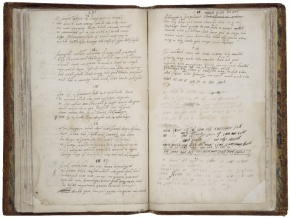
This manuscript miscellany contains secular and religious poetry, as well as a list of books, receipts, and letters. It was written over a number of years, and includes contributions from various members of the household of Lady Anne Southwell and her second husband, Captain Henry Sibthorpe.
More than one-third of the volume is devoted to Southwell’s verse meditations on the ten commandments. On display is part of Southwell’s verse on the eighth commandment, "Thou shalt not steal." The left side and part of the right side are written by one of her copyists, while on the right side, halfway down, you can see a great example of Lady Anne Southwell’s practically indecipherable handwriting—a very distinctive angular italic hand. You can also see her in the act of revising, as she makes corrections to the first line of verse on the right side, altering what the copyist has written, and further down, revising herself using a much darker ink. Seeing a poet in the act of revision is always a very exciting thing, and seeing multiple layers of revision is even more interesting.
This manuscript has perplexed scholars for many years, especially because the first leaf is headed, “The workes of the Lady Ann Sothwell: December: 2 1626,” but is then followed by a series of songs and poems not written by her. None of the explanations for this or other mysteries has proved fully satisfactory.
Hear Wolfe discuss Southwell's manuscript.
Lady Mary Wroth, Urania (case 7)
Margaret Hannay on Lady Mary Wroth
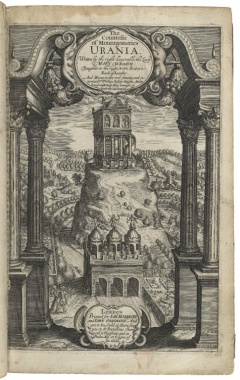
Lady Mary Wroth was the first English woman to write an extended work of prose fiction. She was well placed to observe the aristocracy as the daughter of Robert Sidney, later earl of Leicester, and Barbara Gamage, a Welsh heiress. She was the beloved niece of the wealthy earl and countess of Pembroke. Even after her arranged marriage to Sir Robert Wroth she spent summers at the Sidney estate of Penshurst Place and winters at Baynards Castle, the London home of the Pembrokes. There she conversed with the most prominent politicians and writers, wrote poetry and had it set to music by the best composers, and wrote her prose romance, which was probably read aloud to family and friends. Wroth’s life is as fascinating as the fictions she wrote. At age thirteen, she danced before Queen Elizabeth, and at seventeen, she acted in a court masque with Queen Anne. Wroth watched Shakespeare act in his own plays, heard her relative Sir Walter Raleigh talk about founding Virginia, and almost certainly met Pocahantas and ambassadors from Morocco. Wroth’s later prose fiction echoes elements of her own life, including foreign travel, tragic deaths of siblings, arranged marriage, a lifelong love for her cousin, royal visits to her home, and then civil war.
On the title page of The Countess of Montgomerys, Urania, named for Wroth's close friend Susan, countess of Montgomery, Wroth identifies herself by reference to two famous writers: her uncle Sir Philip Sidney and her aunt Mary Sidney, countess of Pembroke. At the lower left you see a knight and a lady who are approaching the allegorical tower of the Throne of Love; the domes are surmounted with the figures of Cupid, Venus, and Constancy. The hundreds of intersecting tales in this complex work are mostly about love, though they also incorporate political themes. The central tale is about Queen Pamphilia’s love for her cousin, the Emperor Amphilanthus, whose name means "lover of two." Pamphilia takes pride in her constancy to him, even as he repeatedly becomes entangled with other women. This echoes, in fascinating and elusive ways, Wroth’s own love for her cousin William Herbert, earl of Pembroke, even though they both had arranged marriages with others. Wroth had a vivid imagination that took the world she knew and transformed it into fiction, often adding melodramatic flourishes to events that had happened to herself and to those she knew.
Listen to Hannay discuss Urania.
The Mancini Sisters: Mistresses and Memoirists (case 8)
French Salons (case 9)
Elizabeth Goldsmith on the women of the French Salons
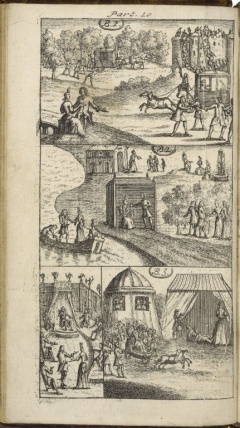
Sociability and politeness were cultivated in the seventeenth-century salons of Madeleine de Scudéry, Marie-Madeleine Pioche de la Vergne, comtesse de Lafayette, Marguerite de la Sablière, and others. Salon society constituted a community apart from the ceremony of court and its rigid hierarchies. Conversation as it was practiced there was focused on maintaining a free-flowing, democratic exchange, without regard to social distinction. Salon conversation was also the means by which many writers, philosophers, and scientists introduced their works to a new worldly public centered around prominent women.
Madeleine de Scudéry presided over her salon gatherings in the 1650s, during the same period in which she was writing her novels. The many conversations that are incorporated into her narratives were drawn from the discussions that were held at her samedis. Much later, at the end of her long career as a writer, Scudéry republished many of these in a series of volumes of printed conversations that were received as models of ideal social interaction and worldly philosophizing. For a time, her collections of conversations were used as textbooks for the instruction of young women at the newly founded school of St. Cyr. Although she had published all of her novels anonymously or under the name of her brother Georges de Scudéry, her conversations were published under her own name.
In the last decades of Louis XIV’s reign, as salon society grew more scattered due to new opportunities for travel as well as the increasingly common experience of exile, letter writing became a means of sustaining the social networks that salon gatherings had created. Letters were viewed as written conversations, and women were thought to be the best at both of these arts. Marie de Rabutin Chantal, marquise de Sévigné was a famous writer during her own lifetime without ever having published. Her letters were circulated, copied by hand, and highly valued for their engaging and informed reporting of events in Paris and at court. They enabled her correspondents to continue their participation in salon conversations via letters that were read aloud and exchanged. In her lively and passionate letters to her daughter, who had been posted to the south of France along with her husband who was Governor of Provence, Sévigné discovered her vocation as a writer.
Hear Goldsmith discuss the French Salons.
Elizabeth C. Goldsmith is a professor of French at Boston University. She has written books on literature and culture in the age of Louis XIV, focusing on conversation, letter correspondences, and women’s writing. Her latest book is The Kings’ Mistresses: The Liberated Lives of Marie Mancini, Princess Colonna,and Her Sister Hortense, Duchess Mazarin (New York: Public Affairs, 2012).
Katherine Philips, Plays and Poems (case 11)
Elizabeth Hageman on Katherine Philips
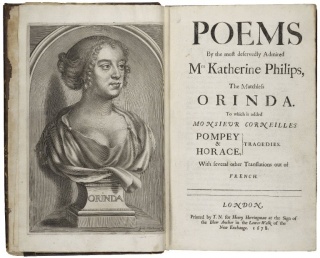
Katherine Philips (1632-1664) is best known today for some 140 poems she wrote on a variety of topics. Most popular among modern readers are a series of wonderful friendship poems, many of which Philips addressed to women whose sobriquets she took from literary texts popular in her own time–names such as Lucasia, Rosania, and Ardelia. Philips’s own sobriquet was Orinda, a name she apparently crafted for herself, modifying female names such as Dorinda and Florinda to create a female name which resembles (perhaps even challenges) the names of male heroes such as Shakespeare’s Orlando and the Greek god Orion.
Philips also wrote a series of letters that were published in 1705 under the title Letters from Orinda to Poliarchus. In addition, she is important to literary history as the first female dramatist whose plays were produced in public theaters in both Dublin and London. (Unlike Aphra Behn, who is known for being the first woman to write professionally for the English stage, Philips was—as far as we know—not paid for either of her plays. Certainly, she was not paid for Horace, for as I note below, it was completed, performed, and printed after her death. And what she says in her letters to Poliarchus (Sir Charles Cotterell) about Pompey suggests that it was produced and then printed by aristocratic friends of hers, rather than as commercial enterprises for which she would be paid.)
If you look at the title page of the printed edition of writings by Katherine Philips, you will see that Philips translated two plays by the French dramatist Pierre Corneille: his Pompey and also his Horace. We don’t know exactly why Philips chose those two plays, but in the context of this exhibit celebrating women’s writing, we should note that each of them features not one, but two important female characters. In Pompey, shown at right in the manuscript version of Philips' plays, the Egyptian leader Ptolomy plots an underhanded way to murder the great Roman warrior Pompey. By the time the play is finished, both Ptolomy and Pompey are dead, but the play’s two women are very much alive. Pompey’s widow Cornelia has shown herself to be a heroically loyal wife, and Ptolomy’s sister, the ambitious and honorable Cleopatra, is celebrated as the new Queen of Egypt.
Philips’s Pompey was performed at the Theatre Royal in Dublin in February, 1663, and that spring it was printed in two editions: one in Dublin (March); the other in London (May). When Philips died of smallpox in June of 1664, she had not quite finished translating Horace, but it was completed by Sir John Denham and performed at the Court of Charles II in February, 1668. In that performance, the king’s mistress Lady Castlemaine played the role of Camilla, and the duchess of Monmouth was her sister-in-law Sabina. During the theatrical season of 1668-69, Horace was then performed by a professional acting company, the King’s Men, at Bridges Theatre in London. Marcelia by Elizabeth Boothby was performed by the King’s Men during the same season—and it was not long before other women—Aphra Behn, Mary Pix, Susanna Centlivre among them—were popular and successful London playwrights.
Listen to Hageman discuss Philips' poems and plays.
Elizabeth Hageman, Professor of English-Emerita at the University of New Hampshire, is English-Language General Editor for The Other Voice Series, a collection of writings by women published by the Centre for Reformation and Renaissance Studies at the University of Toronto. Her own work also centers on writing by and about women, especially the poet and playwright Katherine Philips.
Margaret Cavendish, English Playwright (case 11)
Anna Battigelli on Margaret Cavendish
The volume at the right is one of two folio collections of plays written by Margaret Cavendish, Duchess of Newcastle. Cavendish’s life was shaped by the trauma of the English civil wars. She was a maid of honor to the unpopular Queen Henrietta Maria, with whom she fled into exile. In exile, she married England’s most eligible bachelor, William Cavendish, later Duke of Newcastle, with whom she lived in Paris and Antwerp for sixteen years before returning to London in 1660. With no children and all the resources of her husband’s literary and scientific salon, Cavendish threw herself into the emerging discipline of science, even as she produced fourteen volumes of plays, poems, biographies, scientific treatises, romances, and satire. Hers was a mind on fire — so much so that she would wake her scribe in the middle of the night to take dictation. Her compulsive writing compensated for her pathological shyness. In her books she engaged and challenged her age’s leading thinkers. She satirized the Royal Society, the court, and social conventions. She forwarded copies of her lavish folio volumes to universities and members of the aristocracy. Remarkably, she arranged for an invitation to attend a meeting of the Royal Society, the only woman of her era allowed entrance into this circle of men.
The plays in this volume were written in exile between 1656 and 1660. They revisit the conflicts of the English civil wars, depicting both physical battles and the battles within a divided mind. She probes the incongruity between the external world and the mind’s inner world, between lives of action and contemplation, engagement and retreat. Some of her heroines set out to change the world, defying social conventions by cross-dressing and becoming soldiers; one is even offered a Cardinal’s hat. Other heroines retreat from the world in resignation by creating a monastic life for themselves. Cavendish typically includes both types of heroines within the same play, reflecting her own profound ambivalence about the proper relation between mind and world. In the frontispiece — based on a painting by the Dutch painter Abraham van Diepenbeeck — we see Cavendish situated between two gods of wisdom. On the left is Athena, carrying a shield with Medusa’s head on it; on the right is Apollo, holding his lyre. Both gods gaze on Cavendish. Her gaze, however, eyes the reader, inviting and perhaps even challenging the reader to open the book.
Hear Battigelli discuss Cavendish's plays.
Anna Battigelli is the author of Margaret Cavendish and the Exiles of the Mind. She is Professor of English at the State University of New York at Plattsburgh.
Aphra Behn, The Widow Ranter (case 12)
Nancy Copeland on Aphra Behn
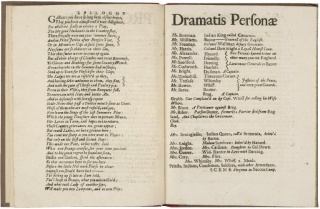
The Widow Ranter was the last play written by Aphra Behn, England’s first professional female playwright. This play was probably written in 1688, but was first performed a few months after Behn’s death in 1689. It is the first surviving play to be set in a North American colony; it takes place in and around Jamestown, Virginia in 1676. As a young woman, Behn may have spent some time in another British colony, Surinam, and she may have drawn on that experience in this play.
The Widow Ranter combines a serious plot with a comic one. The serious plot is loosely based on an historical event: the rebellion of a colonist, Nathaniel Bacon, against Virginia’s colonial government. Bacon himself is the protagonist in this plot: he is portrayed as a noble if flawed character, a hero tragically in love with Semernia, the romantic “queen” of the local Indian tribe; their doomed relationship in some respects recalls the Pocahontas story. The comic plot gives a satirical picture of the colony. The colonists include the bumbling lower-class members of the ruling council; fortune-hunting gentlemen newly arrived from England ; and the Widow Ranter. Ranter came to Virginia as a servant, but became wealthy by marrying her late master. She swears, smokes, and drinks like a man, and pursues and wins a second husband while disguised as a boy. She is a memorable character who embodies the colony’s social chaos but also its vitality. Aphra Behn’s play is a critique of both colonial Virginia and the English political situation at the time it was written, but despite its satire, this play provides an unusual early portrait of a distinctive colonial culture.
Listen to Copeland discuss The Widow Ranter.
Nancy Copeland is Associate Professor of Drama in the University of Toronto’s Centre for Drama, Theatre, and Performance Studies and the Department of English and Drama, University of Toronto Mississauga, where she is also Director of Theatre, Drama, and Performance Studies and Associate Chair. Her publications include an edition of Susanna Centlivre’s A Bold Stroke for a Wife (Broadview,1995); Staging Gender in Behn and Centlivre: Women’s Comedy and the Theatre (Ashgate, 2004); and “Aphra Behn in the Contemporary Theatre” in Teaching British Women Playwrights of the Restoration and Eighteenth Century, ed. Bonnie Nelson and Catherine Burrows. (MLA, 2010).
Susanna Centlivre, The Basset-table (case 12)
Nancy Copeland on Susanna Centlivre
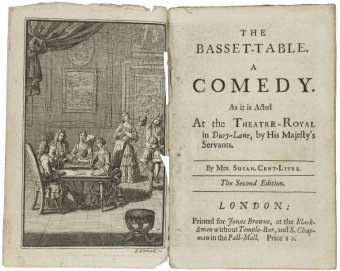
Susanna Centlivre was one of the leading playwrights of her time, who wrote many popular comedies between 1700 and 1723. Her comedy The Basset-table is named after a card game, basset, which was popular with gamblers at the time the play was first performed in 1705. In The Basset-table, Centlivre deals with two important women’s issues of her day: female gamblers and women’s education. Her leading female characters are Lady Reveller, an aristocratic gambler, and her young cousin, Valeria, an amateur scientist. Lady Reveller represents many of the contemporary concerns about female gamblers: she disrupts her family by entertaining other gamblers at her house day and night; she mixes with people below her class, like the merchant’s wife, Mrs. Sago, because she can win money from them; and she exposes herself to unwanted sexual advances when she loses.
Valeria is also a topical character. Her interest in biology is an example of the popularization of scientific knowledge in the early eighteenth century, but, like other learned women of the time, she is satirized for being more interested in pursuing her education than in getting married and having children. Both characters achieve a degree of independence through their unconventional obsessions, but, in the end, each is domesticated by being tricked into marriage to a devoted male admirer. Both Lady Reveller and Valeria are shown in characteristic settings: in one scene we see Lady Reveller playing basset with characters she hopes to “strip” of their money, and the violent reactions of the losers; in another we see Valeria in her laboratory, examining a live fish under a microscope. These colorful scenes, and Valeria, whose scientific aspirations strike a chord with twenty-first-century audiences, have helped make The Basset-table popular today.
Hear Copeland discuss Centlivre's plays.
Anne Finch, plays and verses (case 12)
Jennifer Keith on Anne Finch
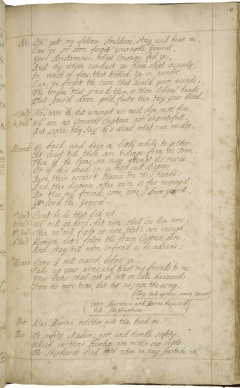
Readers today know of Anne Finch mainly through her poetry, but the volume on display preserves the only manuscript copies of the two plays she is known to have composed, including Aristomenes, or the Royal Shepherd.
Earlier in the same volume, Finch insists that her plays must be shown only to family and friends and never be performed in public. But more than twenty years after this play was written, she authorized its printing as the concluding piece for her Miscellany Poems, on Several Occasions (1713). We have no evidence that explains why she later wished to see the tragedy in print. As years passed, she may have gained confidence in the play’s merit and grew interested in conveying more widely its political themes during the succession crisis near the end of Queen Anne’s reign.
Although Aristomenes uses elements of the pastoral, notably shepherds and their amorous interests, the play is a tragedy focused on a brave soldier’s fight against his country’s usurpers. The character Climander despises the “vile hook” that disguises him temporarily as a harmless shepherd in a rural retreat while he must wait to defend his country. Climander’s retreat parallels that of many English remaining loyal to James II—including Anne and her husband, Heneage Finch—after the revolution of 1688. In Finch’s view, William and Mary had usurped the throne of James II.
Of Finch’s work that survives in manuscript, one of its unusual aspects is its transcriber: her husband, Heneage. In addition to copying out the more than 300 pages of this volume, he copied out two other manuscript volumes. Why did he do this? Did he aim to control, particularly censor, her writing? Or did he wish to help her, particularly given how difficult her own handwriting is to read? Evidence of their cooperation appears throughout the volume. Whereas Heneage copied out his wife’s work, she altered his transcription here and in many other pages. Thanks to this manuscript we have unique evidence of Anne Finch’s revisions and the relation they expose to her husband’s role in her transmitting her work.
Listen to Keith discuss Finch's plays and poems.
Jennifer Keith, Associate Professor of English at the University of North Carolina at Greensboro, is the author of Poetry and the Feminine from Behn to Cowper (2005) and numerous essays on eighteenth-century poetry. She is completing, with Claudia Kairoff, a critical edition of The Works of Anne Finch. The NEH and a Folger long-term fellowship have supported their work on the edition, which will be published in two volumes by Cambridge University Press.
Christine de Pisan, City of Ladies (case 13)
Georgianna Ziegler on Christine de Pisan
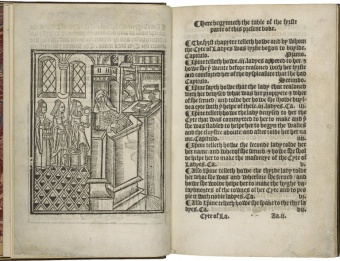
Christine de Pisan is the medieval precursor of all the women writers in Shakespeare's Sisters exhibition. She wrote her most famous work, The Book of the City of Ladies, in 1405, and it circulated widely in manuscript. On display is an English translation published in 1521, early in the reign of Henry VIII. Christine was both Italian and French, having been born in Italy around 1364 and then grown up in France where her physician and astrologer father worked at the court of Charles V. By the time she was twenty-five, both her father and husband had died, leaving her with a mother and three children to support. She embarked on a program of self-education and began writing as a way of supporting her family. She presented her beautifully decorated manuscripts to members of the nobility who rewarded her well.
The Book of the City of Ladies is Christine’s answer to many anti-feminist tracts that circulated in the Middle Ages. She writes that she noticed how many male writers “concur in one conclusion: that the behavior of women is inclined to . . . every vice.”† But when she thought about her own character and about “other women whose company I frequently kept, princesses, great ladies, women of the middle and lower classes, who had graciously told me of their most private and intimate thoughts,”† she could not see how the arguments of these men against women could be true. So she sets out to build a city of ladies, in which she tells the stories of many famous women, mostly from mythology and classical and religious history, whose lives prove their virtuousness and their intelligence. Included are the first women artists and poets, as well as those adept in early science, women who undertook warfare, and those who saved their husbands and others from death. She also gives examples of many women who were chaste and faithful.
At the end she writes: “My most honored ladies, may God be praised, for now our City is entirely finished . . . where all of you who love glory, virtue, and praise may be lodged in great honor, ladies from the past as well as from the present and future, for it has been built and established for every honorable lady.”†
†Translations by Earl Jeffrey Richards
Listen to Ziegler discuss de Pizan's City of Ladies.
Virginia Woolf (1882-1941) and Vita Sackville-West (1893-1962) (case 14)
Georgianna Ziegler on Virginia Woolf and Vita Sackville-West
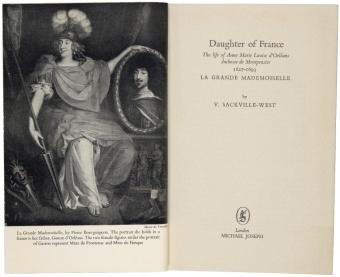
Today we recognize Virginia Woolf as the most prominent English woman intellectual and writer in the early twentieth century. Though educated at home, first by her father Leslie Stephen (editor of the Dictionary of National Biography) and then by a self-directed program, Woolf read widely in English literature and history, and was especially drawn to biography. In her writings—book reviews, essays, novels—Woolf developed a highly personal style reflecting her own views. She was a major proponent of better educational opportunities for women and enough financial support to allow them the independence to write in a “room of their own.”
In the 1920s Woolf began an intimate friendship with Vita Sackville-West, another intelligent woman, writer, and superb gardener. Born into an old aristocratic family, Sackville-West lived at Knole in Kent and was related to the Cliffords. She edited Lady Anne Clifford’s diary, found among the family papers at Knole, and she wrote biographies of Aphra Behn and the duchesse de Montpensier, as well as histories, novels, and essays on gardening. It was West’s association with her historic land and home that inspired Woolf to write Orlando (1928). This gender- and time-bending novel follows the androgynous figure Orlando from a young man in the Elizabethan period, living at Knole, to a young woman just after World War I. Changing her character’s identity allowed Woolf to explore the differences and similarities in the ways women and men view the world. It was also a way for her to represent her belief that “in each of us two powers preside, one male, one female,” and that “the normal and comfortable state of being . . . [occurs] when the two live in harmony together.” †
Thirty years after Woolf’s tragic suicide in 1941, her writings became a manifesto for feminist scholars who were trying to recuperate the many historical women writers whose voices had been lost. Woolf’s book, A Room of One’s Own, published in 1929 became required reading in hundreds of new women’s studies courses. In this book, Woolf imagined a sister for Shakespeare named Judith, whose attempts to be a playwright like her brother were doomed to failure by society’s restrictions on women’s behavior. We now know that opportunities for women did exist within the social fabric of early modern England, and we have recovered many more writers than Woolf could ever have known. Many of these early women circulated their writings in manuscript form, or their books were published once and then forgotten, and it has taken years of serious archival digging to bring them to light. Woolf did know about some of these women. Her essays contain references to writers such as Aphra Behn, Margaret Cavendish, Lady Anne Clifford, Anne Finch, and Madame de Sévigné.
At the end of A Room of One’s Own, Woolf comes back to Shakespeare’s imagined sister, seeing her thwarted career revived by modern women. “She lives in you and in me, and in many other women who are not here tonight, for they are washing up the dishes and putting the children to bed,” Woolf writes. “But she lives; for great poets do not die . . . they need only the opportunity to walk among us in the flesh.” “This opportunity,” Woolf tells her early twentieth-century audience, “is now coming within your power to give her.”†
† Quotations from A Room of One’s Own (NY: Harcourt, Brace & World, 1929; 1957)
